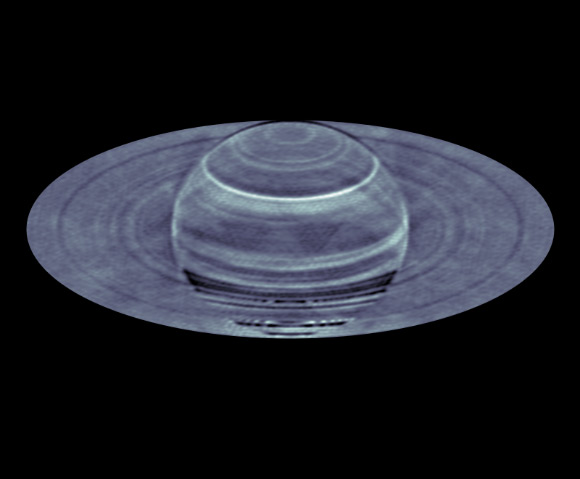Planetary-scale giant storms erupt on Saturn periodically. There have been at least six recorded occurrences of past eruptions, and the most recent one was in 2010, with its whole life span captured by NASA’s Cassini mission. To find out more about these megastorms, University of California, Berkeley’s Professor Imke de Pater and her colleagues had to probe layers in the Saturnian atmosphere below the clouds, which are invisible to the human eye. That’s why the astronomers turned to NSF’s Karl G. Jansky Very Large Array (VLA).

For most of the time, Saturn’s atmosphere looks hazy and featureless to the naked eye in contrast to Jupiter’s colorful and vibrant atmosphere. This picture changes when we look at Saturn using a radio eye. Despite bland looking at the visible wavelengths, different latitudes on Saturn show dramatic contrast in the radio emission. In 2015, Li et al. found substantial brightness temperature variations — greater than the temperature increase caused by the 2010 storm — as a function of latitude and radio wavelength based on spatially resolved radio images of Saturn, as obtained from the VLA. Via a spectral inversion study, they created a latitude-altitude map of ammonia concentration anomalies from these images and correlate the anomalies to the occurrences of past giant storms in the northern hemisphere. Image credit: S. Dagnello / NRAO / AUI / NSF / Li et al., doi: 10.1126/sciadv.adg9419.
Every 20 to 30 years, a giant storm erupts on Saturn, creating enormous cloud disturbances with a clear head marching forward until it wraps around the whole planet.
The most recent eruption was in 2010, with visible cloud activities lasting for more than 6 months.
At that time, NASA’s Cassini spacecraft was still orbiting Saturn and the on-board instruments, including the visible camera, radio instruments, infrared camera, and radar, returned exquisite details of the astronomical feast.
The next event is expected to happen within 10 to 20 years, based on prior statistics and the understanding of the storm dynamics.
In 2015, Professor de Pater and co-authors used VLA to probe the deep response of Saturn’s atmosphere to the giant storms.
In addition to the remnant effect of the storm in 2010, they found long-lasting signatures of all mid-latitude giant storms, a mixture of equatorial storms up to hundreds of years old, and potentially an unreported older storm at 70°N.
“At radio wavelengths, we probe below the visible cloud layers on giant planets,” Professor de Pater said.
“Since chemical reactions and dynamics will alter the composition of a planet’s atmosphere, observations below these cloud layers are required to constrain the planet’s true atmospheric composition, a key parameter for planet formation models.”
“Radio observations help characterize dynamical, physical, and chemical processes including heat transport, cloud formation, and convection in the atmospheres of giant planets on both global and local scales.”
With the power of radio to look beyond the clouds in the Saturnian troposphere, the astronomers found something surprising: anomalies in the concentration of ammonia gas in the atmosphere, which they connected to the past occurrences of megastorms in the planet’s northern hemisphere.
According to the researchers, the concentration of ammonia is lower at mid-altitudes in the atmosphere but has become enriched at lower altitudes.
They believe that the ammonia is being transported from the upper to the lower atmosphere via the processes of precipitation and re-evaporation. What’s more, that effect can last for hundreds of years.
Saturn is really nothing like Jupiter after all and that could have implications for future research.
The scientists further revealed that although both Saturn and Jupiter are both made of hydrogen gas, the two gas giants are remarkably dissimilar.
While Jupiter does have tropospheric anomalies, they have been tied to its zones, and are not caused by storms like they are on Saturn.
This considerable difference between these neighboring gas giants is challenging what astronomers know about the formation of megastorms on gas giants and other planets and may inform how they’re found and studied on exoplanets in the future.
“Understanding the mechanisms of the largest storms in the Solar System puts the theory of hurricanes into a broader cosmic context, challenging our current knowledge and pushing the boundaries of terrestrial meteorology,” said Dr. Cheng Li, an astronomer at the University of Michigan-Ann Arbor.
The findings were published in the journal Science Advances.
_____
Cheng Li et al. 2023. Long-lasting, deep effect of Saturn’s giant storms. Science Advances 9 (32); doi: 10.1126/sciadv.adg9419







